Identification of needs in Maslow’s hierarchy theory
VerifiedAdded on 2023/04/06
|6
|1222
|471
AI Summary
This article discusses the identification of needs in Maslow’s hierarchy theory and how they are reflected in advertisements. It also explores the buying motives and the use of product features in advertisements.
Contribute Materials
Your contribution can guide someone’s learning journey. Share your
documents today.
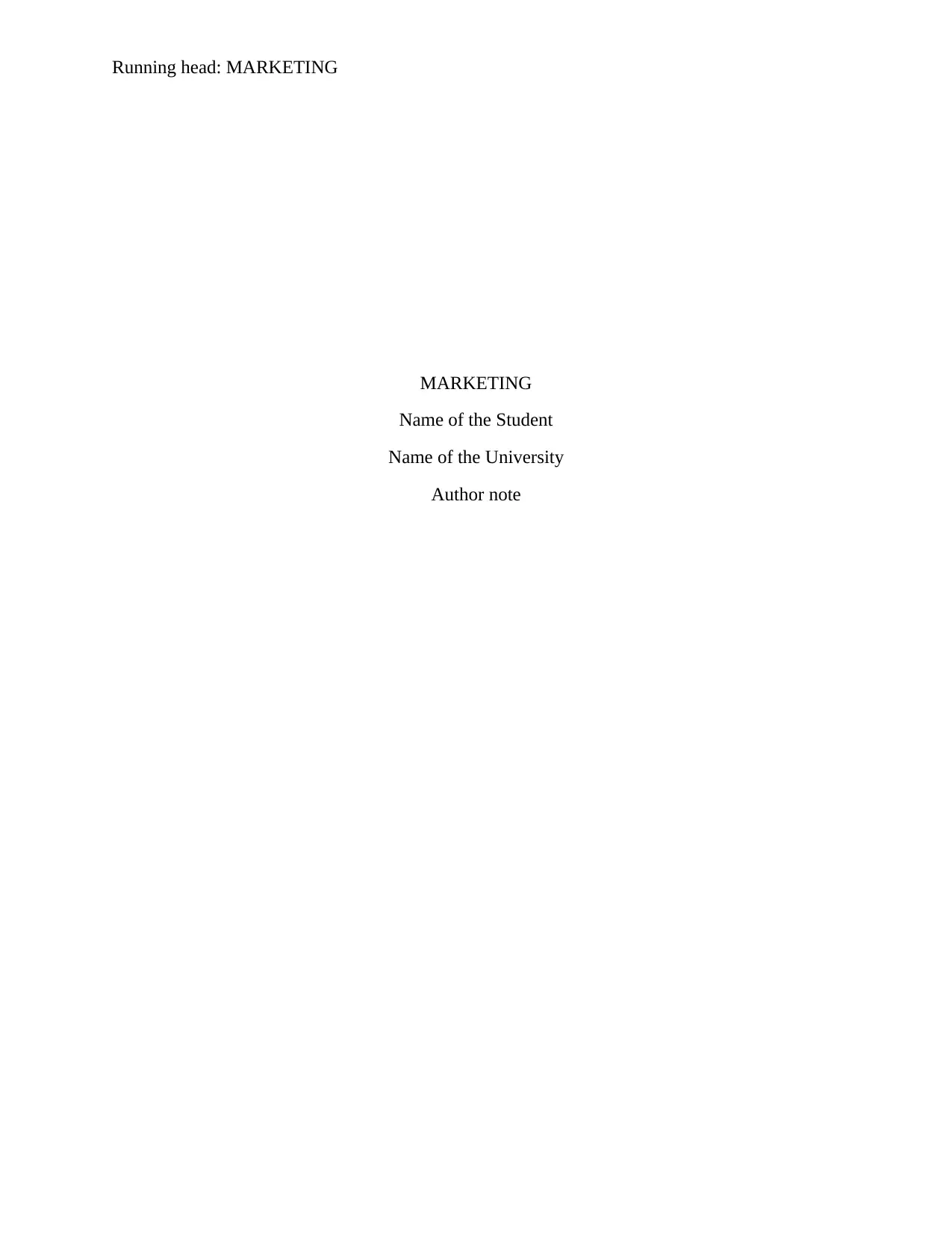
Running head: MARKETING
MARKETING
Name of the Student
Name of the University
Author note
MARKETING
Name of the Student
Name of the University
Author note
Secure Best Marks with AI Grader
Need help grading? Try our AI Grader for instant feedback on your assignments.
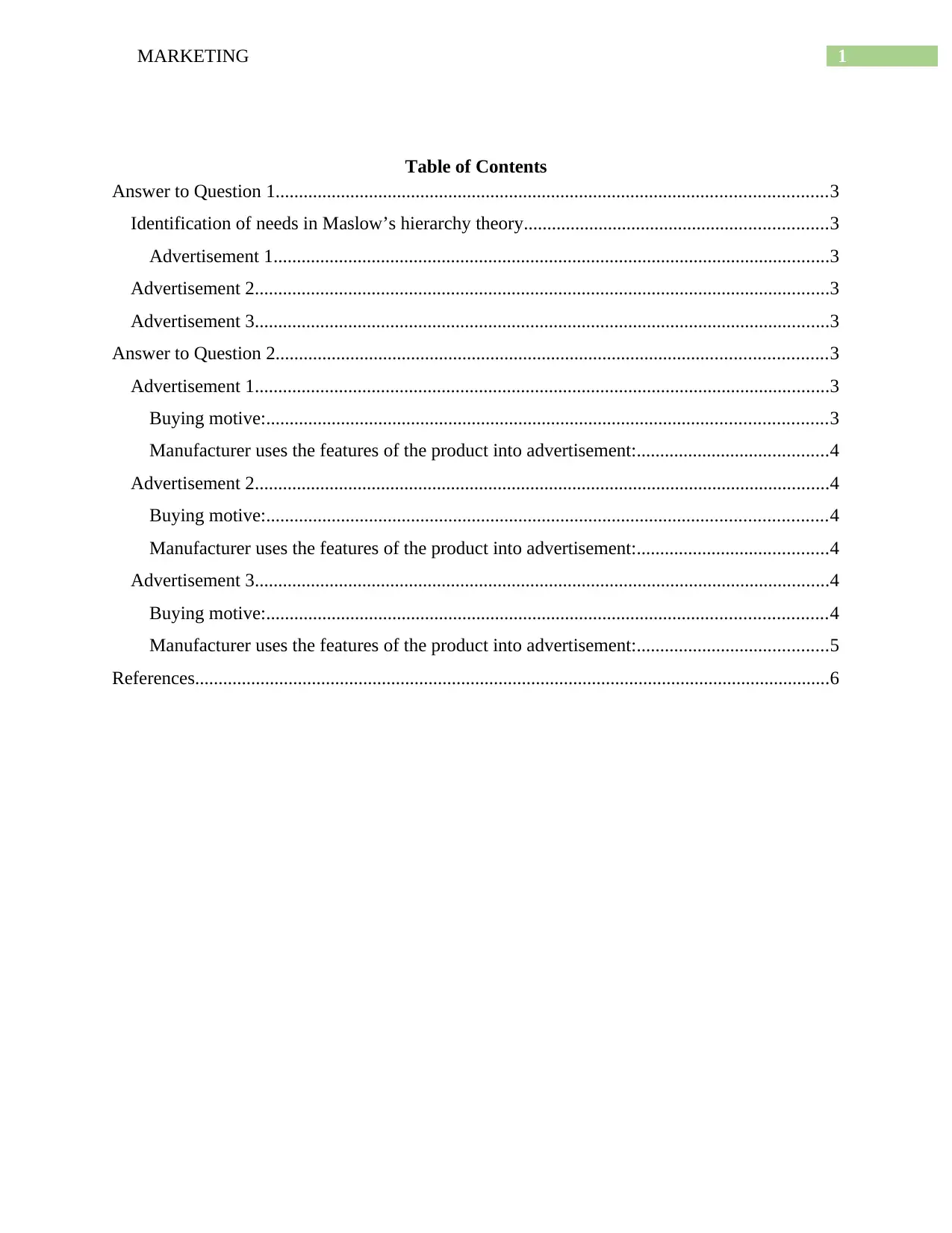
1MARKETING
Table of Contents
Answer to Question 1......................................................................................................................3
Identification of needs in Maslow’s hierarchy theory.................................................................3
Advertisement 1.......................................................................................................................3
Advertisement 2...........................................................................................................................3
Advertisement 3...........................................................................................................................3
Answer to Question 2......................................................................................................................3
Advertisement 1...........................................................................................................................3
Buying motive:........................................................................................................................3
Manufacturer uses the features of the product into advertisement:.........................................4
Advertisement 2...........................................................................................................................4
Buying motive:........................................................................................................................4
Manufacturer uses the features of the product into advertisement:.........................................4
Advertisement 3...........................................................................................................................4
Buying motive:........................................................................................................................4
Manufacturer uses the features of the product into advertisement:.........................................5
References........................................................................................................................................6
Table of Contents
Answer to Question 1......................................................................................................................3
Identification of needs in Maslow’s hierarchy theory.................................................................3
Advertisement 1.......................................................................................................................3
Advertisement 2...........................................................................................................................3
Advertisement 3...........................................................................................................................3
Answer to Question 2......................................................................................................................3
Advertisement 1...........................................................................................................................3
Buying motive:........................................................................................................................3
Manufacturer uses the features of the product into advertisement:.........................................4
Advertisement 2...........................................................................................................................4
Buying motive:........................................................................................................................4
Manufacturer uses the features of the product into advertisement:.........................................4
Advertisement 3...........................................................................................................................4
Buying motive:........................................................................................................................4
Manufacturer uses the features of the product into advertisement:.........................................5
References........................................................................................................................................6
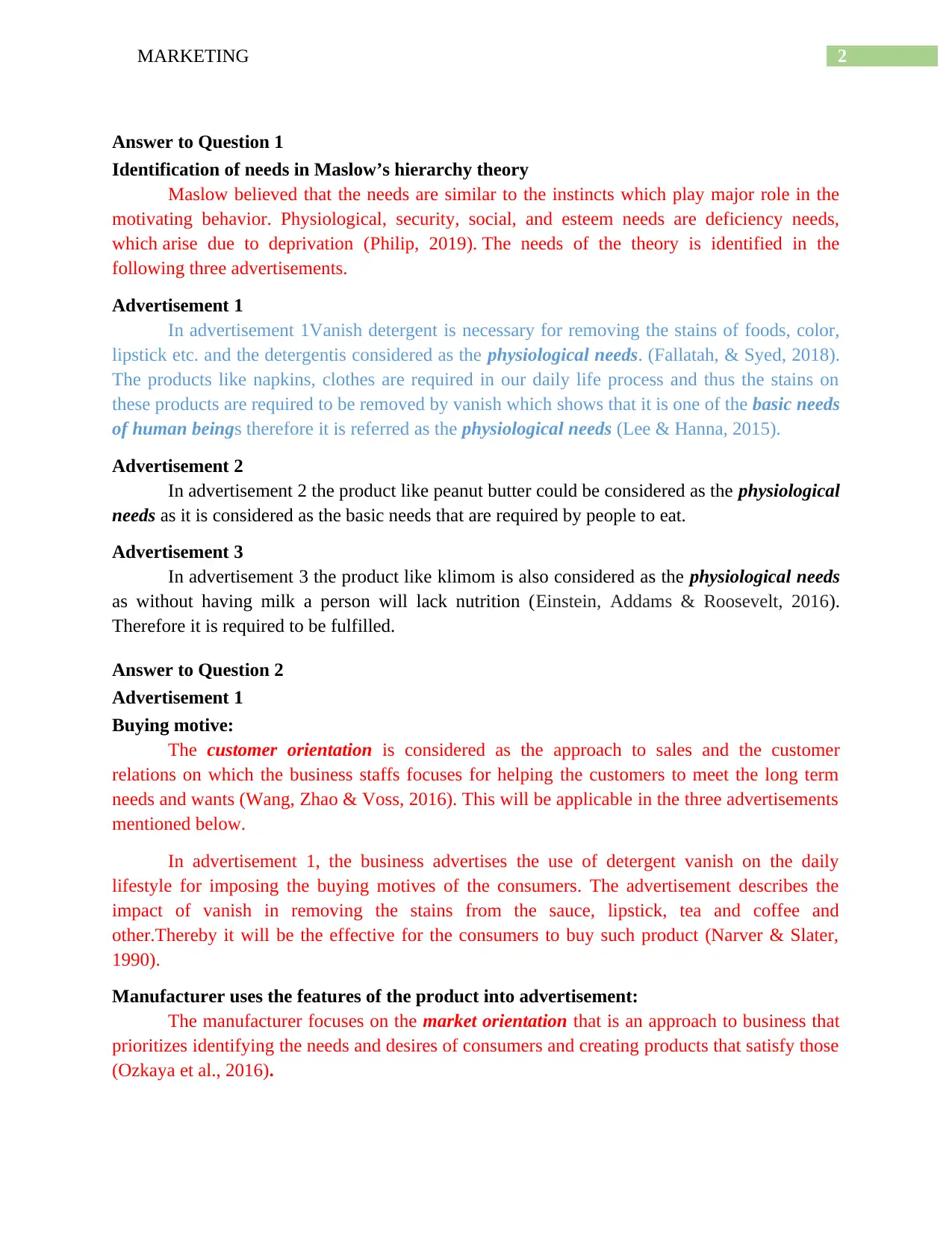
2MARKETING
Answer to Question 1
Identification of needs in Maslow’s hierarchy theory
Maslow believed that the needs are similar to the instincts which play major role in the
motivating behavior. Physiological, security, social, and esteem needs are deficiency needs,
which arise due to deprivation (Philip, 2019). The needs of the theory is identified in the
following three advertisements.
Advertisement 1
In advertisement 1Vanish detergent is necessary for removing the stains of foods, color,
lipstick etc. and the detergentis considered as the physiological needs. (Fallatah, & Syed, 2018).
The products like napkins, clothes are required in our daily life process and thus the stains on
these products are required to be removed by vanish which shows that it is one of the basic needs
of human beings therefore it is referred as the physiological needs (Lee & Hanna, 2015).
Advertisement 2
In advertisement 2 the product like peanut butter could be considered as the physiological
needs as it is considered as the basic needs that are required by people to eat.
Advertisement 3
In advertisement 3 the product like klimom is also considered as the physiological needs
as without having milk a person will lack nutrition (Einstein, Addams & Roosevelt, 2016).
Therefore it is required to be fulfilled.
Answer to Question 2
Advertisement 1
Buying motive:
The customer orientation is considered as the approach to sales and the customer
relations on which the business staffs focuses for helping the customers to meet the long term
needs and wants (Wang, Zhao & Voss, 2016). This will be applicable in the three advertisements
mentioned below.
In advertisement 1, the business advertises the use of detergent vanish on the daily
lifestyle for imposing the buying motives of the consumers. The advertisement describes the
impact of vanish in removing the stains from the sauce, lipstick, tea and coffee and
other.Thereby it will be the effective for the consumers to buy such product (Narver & Slater,
1990).
Manufacturer uses the features of the product into advertisement:
The manufacturer focuses on the market orientation that is an approach to business that
prioritizes identifying the needs and desires of consumers and creating products that satisfy those
(Ozkaya et al., 2016).
Answer to Question 1
Identification of needs in Maslow’s hierarchy theory
Maslow believed that the needs are similar to the instincts which play major role in the
motivating behavior. Physiological, security, social, and esteem needs are deficiency needs,
which arise due to deprivation (Philip, 2019). The needs of the theory is identified in the
following three advertisements.
Advertisement 1
In advertisement 1Vanish detergent is necessary for removing the stains of foods, color,
lipstick etc. and the detergentis considered as the physiological needs. (Fallatah, & Syed, 2018).
The products like napkins, clothes are required in our daily life process and thus the stains on
these products are required to be removed by vanish which shows that it is one of the basic needs
of human beings therefore it is referred as the physiological needs (Lee & Hanna, 2015).
Advertisement 2
In advertisement 2 the product like peanut butter could be considered as the physiological
needs as it is considered as the basic needs that are required by people to eat.
Advertisement 3
In advertisement 3 the product like klimom is also considered as the physiological needs
as without having milk a person will lack nutrition (Einstein, Addams & Roosevelt, 2016).
Therefore it is required to be fulfilled.
Answer to Question 2
Advertisement 1
Buying motive:
The customer orientation is considered as the approach to sales and the customer
relations on which the business staffs focuses for helping the customers to meet the long term
needs and wants (Wang, Zhao & Voss, 2016). This will be applicable in the three advertisements
mentioned below.
In advertisement 1, the business advertises the use of detergent vanish on the daily
lifestyle for imposing the buying motives of the consumers. The advertisement describes the
impact of vanish in removing the stains from the sauce, lipstick, tea and coffee and
other.Thereby it will be the effective for the consumers to buy such product (Narver & Slater,
1990).
Manufacturer uses the features of the product into advertisement:
The manufacturer focuses on the market orientation that is an approach to business that
prioritizes identifying the needs and desires of consumers and creating products that satisfy those
(Ozkaya et al., 2016).
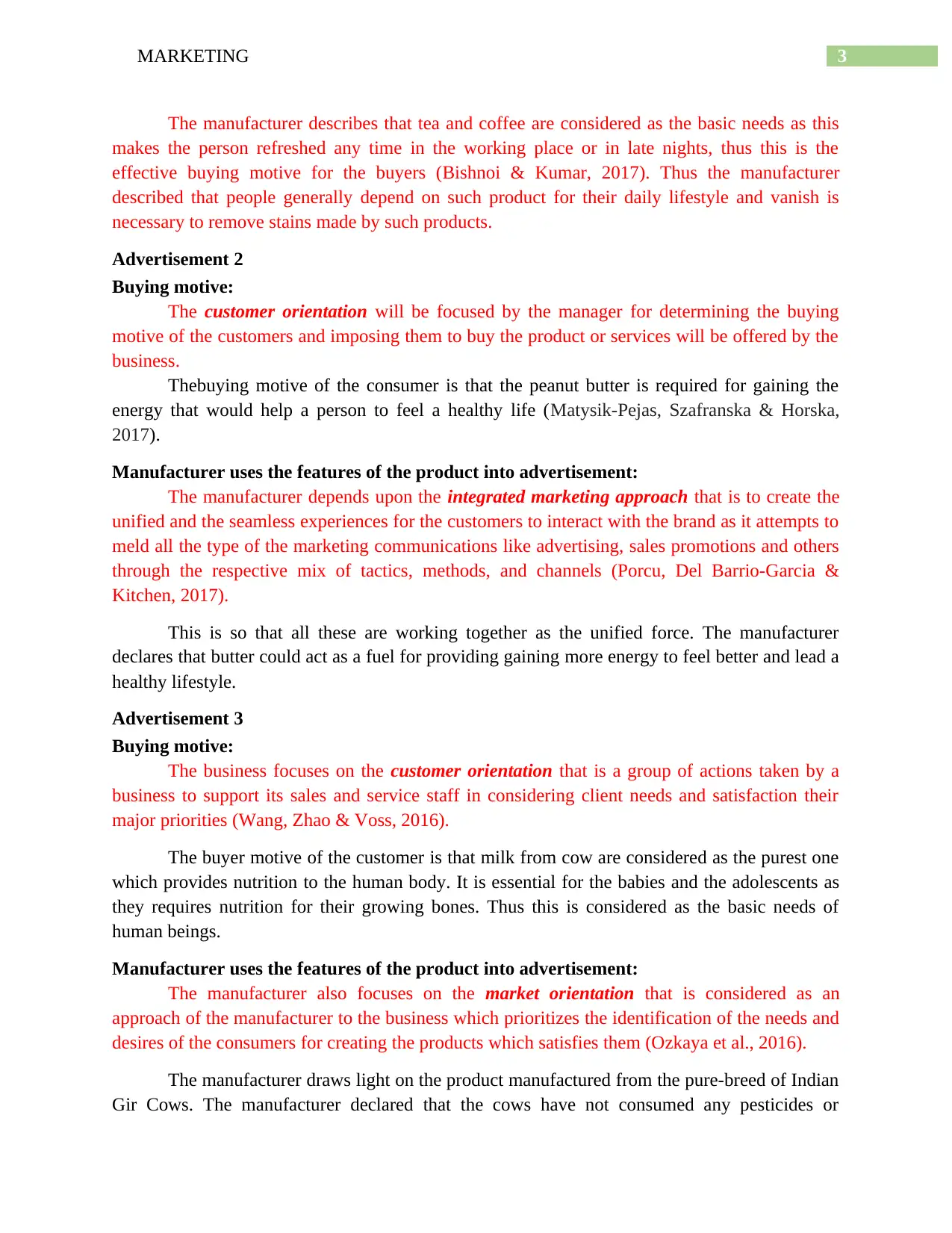
3MARKETING
The manufacturer describes that tea and coffee are considered as the basic needs as this
makes the person refreshed any time in the working place or in late nights, thus this is the
effective buying motive for the buyers (Bishnoi & Kumar, 2017). Thus the manufacturer
described that people generally depend on such product for their daily lifestyle and vanish is
necessary to remove stains made by such products.
Advertisement 2
Buying motive:
The customer orientation will be focused by the manager for determining the buying
motive of the customers and imposing them to buy the product or services will be offered by the
business.
Thebuying motive of the consumer is that the peanut butter is required for gaining the
energy that would help a person to feel a healthy life (Matysik-Pejas, Szafranska & Horska,
2017).
Manufacturer uses the features of the product into advertisement:
The manufacturer depends upon the integrated marketing approach that is to create the
unified and the seamless experiences for the customers to interact with the brand as it attempts to
meld all the type of the marketing communications like advertising, sales promotions and others
through the respective mix of tactics, methods, and channels (Porcu, Del Barrio-Garcia &
Kitchen, 2017).
This is so that all these are working together as the unified force. The manufacturer
declares that butter could act as a fuel for providing gaining more energy to feel better and lead a
healthy lifestyle.
Advertisement 3
Buying motive:
The business focuses on the customer orientation that is a group of actions taken by a
business to support its sales and service staff in considering client needs and satisfaction their
major priorities (Wang, Zhao & Voss, 2016).
The buyer motive of the customer is that milk from cow are considered as the purest one
which provides nutrition to the human body. It is essential for the babies and the adolescents as
they requires nutrition for their growing bones. Thus this is considered as the basic needs of
human beings.
Manufacturer uses the features of the product into advertisement:
The manufacturer also focuses on the market orientation that is considered as an
approach of the manufacturer to the business which prioritizes the identification of the needs and
desires of the consumers for creating the products which satisfies them (Ozkaya et al., 2016).
The manufacturer draws light on the product manufactured from the pure-breed of Indian
Gir Cows. The manufacturer declared that the cows have not consumed any pesticides or
The manufacturer describes that tea and coffee are considered as the basic needs as this
makes the person refreshed any time in the working place or in late nights, thus this is the
effective buying motive for the buyers (Bishnoi & Kumar, 2017). Thus the manufacturer
described that people generally depend on such product for their daily lifestyle and vanish is
necessary to remove stains made by such products.
Advertisement 2
Buying motive:
The customer orientation will be focused by the manager for determining the buying
motive of the customers and imposing them to buy the product or services will be offered by the
business.
Thebuying motive of the consumer is that the peanut butter is required for gaining the
energy that would help a person to feel a healthy life (Matysik-Pejas, Szafranska & Horska,
2017).
Manufacturer uses the features of the product into advertisement:
The manufacturer depends upon the integrated marketing approach that is to create the
unified and the seamless experiences for the customers to interact with the brand as it attempts to
meld all the type of the marketing communications like advertising, sales promotions and others
through the respective mix of tactics, methods, and channels (Porcu, Del Barrio-Garcia &
Kitchen, 2017).
This is so that all these are working together as the unified force. The manufacturer
declares that butter could act as a fuel for providing gaining more energy to feel better and lead a
healthy lifestyle.
Advertisement 3
Buying motive:
The business focuses on the customer orientation that is a group of actions taken by a
business to support its sales and service staff in considering client needs and satisfaction their
major priorities (Wang, Zhao & Voss, 2016).
The buyer motive of the customer is that milk from cow are considered as the purest one
which provides nutrition to the human body. It is essential for the babies and the adolescents as
they requires nutrition for their growing bones. Thus this is considered as the basic needs of
human beings.
Manufacturer uses the features of the product into advertisement:
The manufacturer also focuses on the market orientation that is considered as an
approach of the manufacturer to the business which prioritizes the identification of the needs and
desires of the consumers for creating the products which satisfies them (Ozkaya et al., 2016).
The manufacturer draws light on the product manufactured from the pure-breed of Indian
Gir Cows. The manufacturer declared that the cows have not consumed any pesticides or
Paraphrase This Document
Need a fresh take? Get an instant paraphrase of this document with our AI Paraphraser
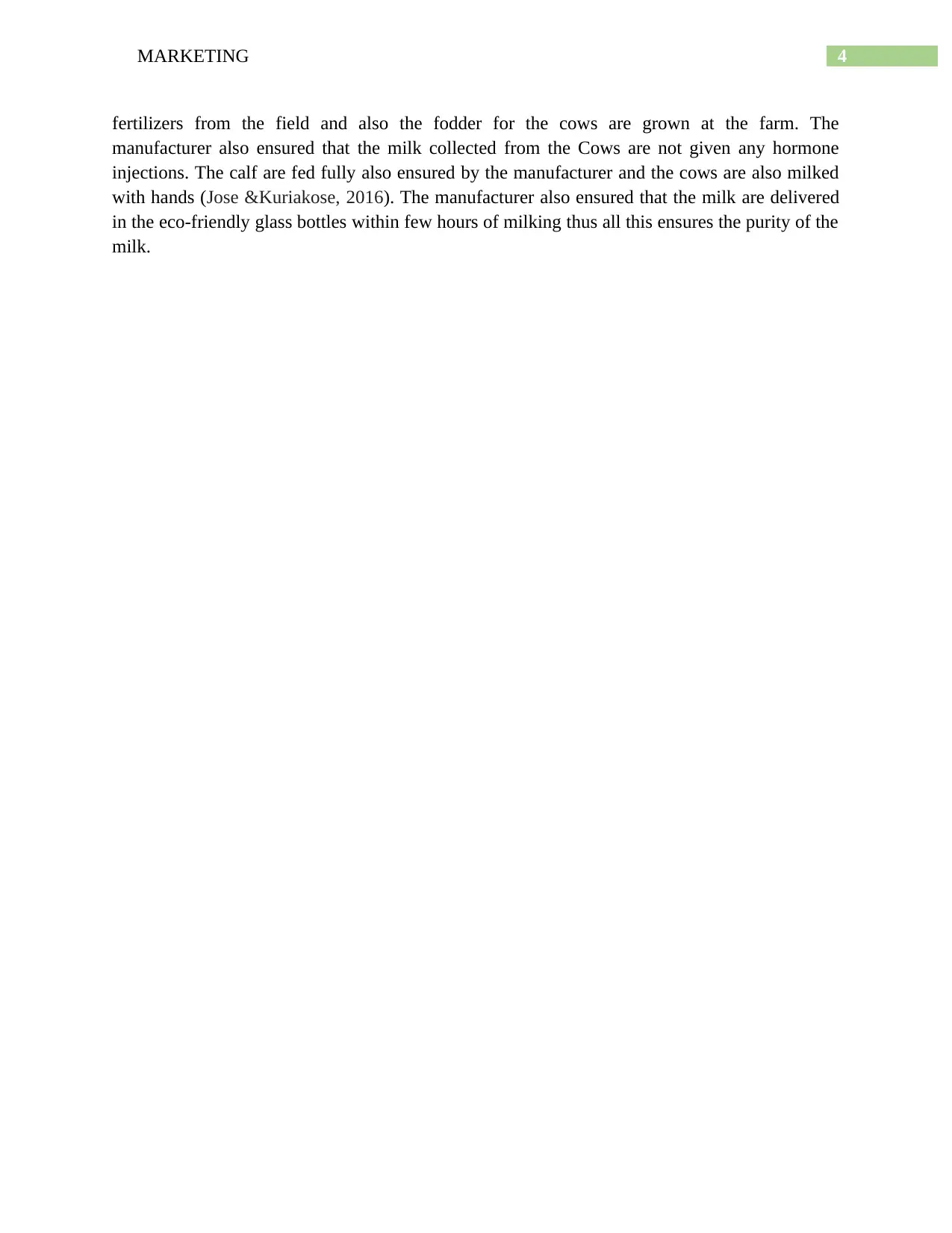
4MARKETING
fertilizers from the field and also the fodder for the cows are grown at the farm. The
manufacturer also ensured that the milk collected from the Cows are not given any hormone
injections. The calf are fed fully also ensured by the manufacturer and the cows are also milked
with hands (Jose &Kuriakose, 2016). The manufacturer also ensured that the milk are delivered
in the eco-friendly glass bottles within few hours of milking thus all this ensures the purity of the
milk.
fertilizers from the field and also the fodder for the cows are grown at the farm. The
manufacturer also ensured that the milk collected from the Cows are not given any hormone
injections. The calf are fed fully also ensured by the manufacturer and the cows are also milked
with hands (Jose &Kuriakose, 2016). The manufacturer also ensured that the milk are delivered
in the eco-friendly glass bottles within few hours of milking thus all this ensures the purity of the
milk.
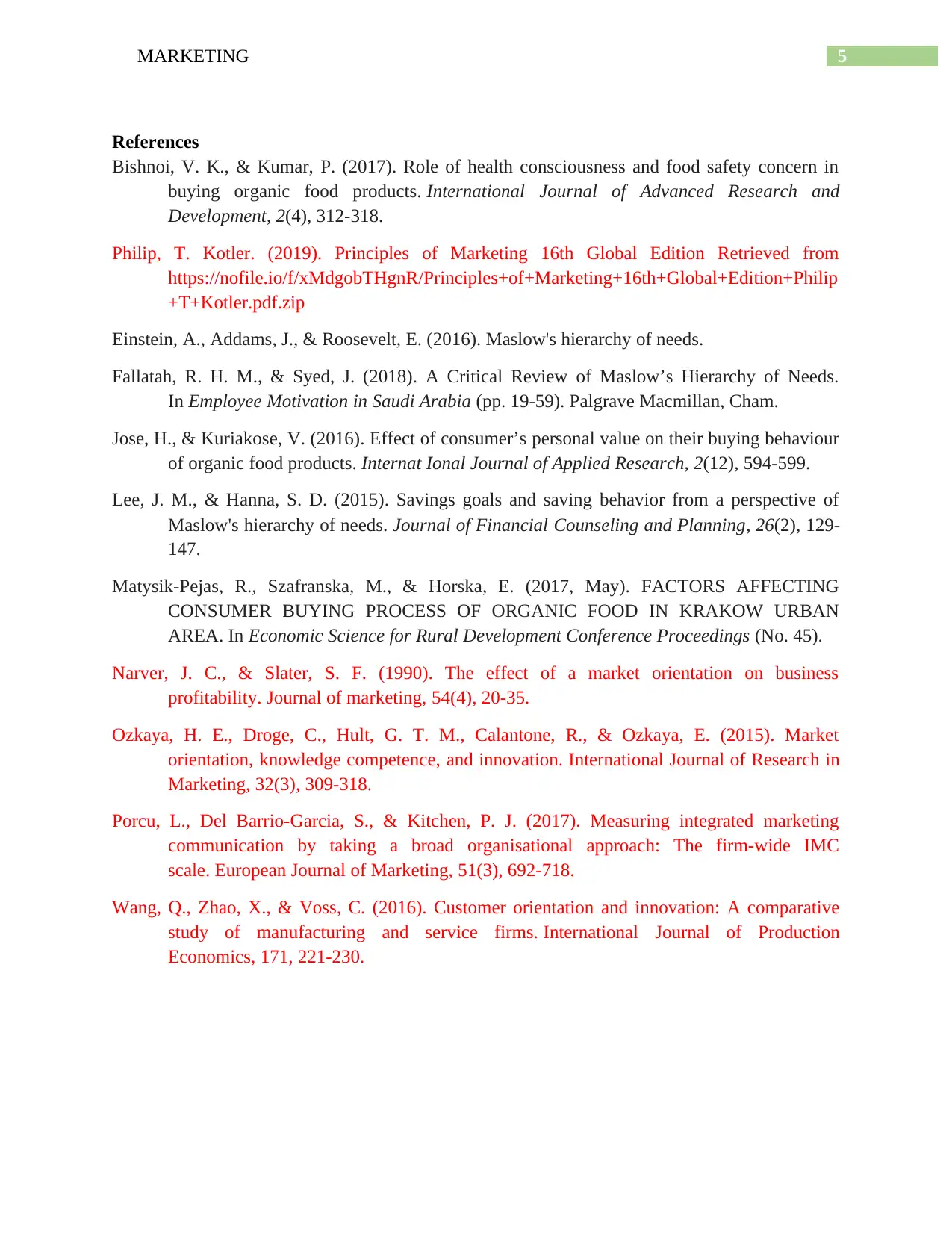
5MARKETING
References
Bishnoi, V. K., & Kumar, P. (2017). Role of health consciousness and food safety concern in
buying organic food products. International Journal of Advanced Research and
Development, 2(4), 312-318.
Philip, T. Kotler. (2019). Principles of Marketing 16th Global Edition Retrieved from
https://nofile.io/f/xMdgobTHgnR/Principles+of+Marketing+16th+Global+Edition+Philip
+T+Kotler.pdf.zip
Einstein, A., Addams, J., & Roosevelt, E. (2016). Maslow's hierarchy of needs.
Fallatah, R. H. M., & Syed, J. (2018). A Critical Review of Maslow’s Hierarchy of Needs.
In Employee Motivation in Saudi Arabia (pp. 19-59). Palgrave Macmillan, Cham.
Jose, H., & Kuriakose, V. (2016). Effect of consumer’s personal value on their buying behaviour
of organic food products. Internat Ional Journal of Applied Research, 2(12), 594-599.
Lee, J. M., & Hanna, S. D. (2015). Savings goals and saving behavior from a perspective of
Maslow's hierarchy of needs. Journal of Financial Counseling and Planning, 26(2), 129-
147.
Matysik-Pejas, R., Szafranska, M., & Horska, E. (2017, May). FACTORS AFFECTING
CONSUMER BUYING PROCESS OF ORGANIC FOOD IN KRAKOW URBAN
AREA. In Economic Science for Rural Development Conference Proceedings (No. 45).
Narver, J. C., & Slater, S. F. (1990). The effect of a market orientation on business
profitability. Journal of marketing, 54(4), 20-35.
Ozkaya, H. E., Droge, C., Hult, G. T. M., Calantone, R., & Ozkaya, E. (2015). Market
orientation, knowledge competence, and innovation. International Journal of Research in
Marketing, 32(3), 309-318.
Porcu, L., Del Barrio-Garcia, S., & Kitchen, P. J. (2017). Measuring integrated marketing
communication by taking a broad organisational approach: The firm-wide IMC
scale. European Journal of Marketing, 51(3), 692-718.
Wang, Q., Zhao, X., & Voss, C. (2016). Customer orientation and innovation: A comparative
study of manufacturing and service firms. International Journal of Production
Economics, 171, 221-230.
References
Bishnoi, V. K., & Kumar, P. (2017). Role of health consciousness and food safety concern in
buying organic food products. International Journal of Advanced Research and
Development, 2(4), 312-318.
Philip, T. Kotler. (2019). Principles of Marketing 16th Global Edition Retrieved from
https://nofile.io/f/xMdgobTHgnR/Principles+of+Marketing+16th+Global+Edition+Philip
+T+Kotler.pdf.zip
Einstein, A., Addams, J., & Roosevelt, E. (2016). Maslow's hierarchy of needs.
Fallatah, R. H. M., & Syed, J. (2018). A Critical Review of Maslow’s Hierarchy of Needs.
In Employee Motivation in Saudi Arabia (pp. 19-59). Palgrave Macmillan, Cham.
Jose, H., & Kuriakose, V. (2016). Effect of consumer’s personal value on their buying behaviour
of organic food products. Internat Ional Journal of Applied Research, 2(12), 594-599.
Lee, J. M., & Hanna, S. D. (2015). Savings goals and saving behavior from a perspective of
Maslow's hierarchy of needs. Journal of Financial Counseling and Planning, 26(2), 129-
147.
Matysik-Pejas, R., Szafranska, M., & Horska, E. (2017, May). FACTORS AFFECTING
CONSUMER BUYING PROCESS OF ORGANIC FOOD IN KRAKOW URBAN
AREA. In Economic Science for Rural Development Conference Proceedings (No. 45).
Narver, J. C., & Slater, S. F. (1990). The effect of a market orientation on business
profitability. Journal of marketing, 54(4), 20-35.
Ozkaya, H. E., Droge, C., Hult, G. T. M., Calantone, R., & Ozkaya, E. (2015). Market
orientation, knowledge competence, and innovation. International Journal of Research in
Marketing, 32(3), 309-318.
Porcu, L., Del Barrio-Garcia, S., & Kitchen, P. J. (2017). Measuring integrated marketing
communication by taking a broad organisational approach: The firm-wide IMC
scale. European Journal of Marketing, 51(3), 692-718.
Wang, Q., Zhao, X., & Voss, C. (2016). Customer orientation and innovation: A comparative
study of manufacturing and service firms. International Journal of Production
Economics, 171, 221-230.
1 out of 6
![[object Object]](/_next/static/media/star-bottom.7253800d.svg)



